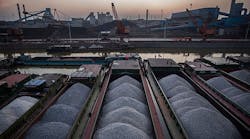It has often been said that China will grow old before it becomes rich. But could it have too many offices, restaurants, and hotels before it becomes wealthy?
That’s the warning from HSBC Holdings Plc’s China economists, led by Qu Hongbin, in a report published Thursday. Given China’s GDP per capita is only 14% that of the U.S., it’s too early for Beijing to eschew manufacturing in favor of services, with the latter’s growth risking a fall in the economy’s productivity in the medium-term, the analysts caution. In short, the faster the services growth, the slower the productivity growth.
The recent services boom — which has prevented a hard landing for the economy and kept unemployment in check for the past three years — could be too much of a good thing. Too many migrant workers that were previously in the agricultural sector are now gainfully employed in the less-productive services sectors, the analysts say:
“The pace of expansion in the services sector has remained strong in recent years, as growth in the industrial sector lost steam. This has helped cushion the slowdown in the overall economy, but such a ‘rebalancing’ also means that labor-intensive services have been replacing manufacturing as the main absorber of rural migrant labor.
“Since labor productivity in these low-end service sector jobs is less than half that in the manufacturing sector, this implies productivity growth through rural-urban labor migration has started to slow, clouding the medium/long-term growth prospects if this trend is entrenched.”
The services sector in China has been on a tear, growing 8.1% year-on-year between 2012 and 2015, cushioning the impact of the slowdown in the industrial sector. In the second quarter of the year, the services sector accounted for 51.9% of real GDP growth, compared with 40.7% for the industrial sector, according to HSBC. The growth in the services sector represents a watershed in China’s growth model, with the industrial sector’s three-decade bull-run largely driving China’s stunning growth rates.
While services such as real estate and finance offer high productivity, migrant workers tend to cluster around lower-end sector such as retail, transportation, and logistics — dragging down the average output-per-worker in the economy as a whole since the services sector in China is only 80% as productive as the industrial sector, according to HSBC.
“With weakening growth momentum in the manufacturing sector (investment growth in the sector has continued to decelerate over the past few months, from 7.5% year-on-year in January 2016 to 1.3% year-on-year in May 2016), China faces the danger of losing more good jobs in exchange for less productive ones. The efficiency loss during such a ‘rebalancing’ can be huge. Between 2012 and 2015, the total number of migrant workers in the manufacturing sector declined by nearly 7 million, compared with an increase of 5 million in the three biggest services sectors (i.e. wholesale and retail, residential services, transportation and logistics.”
Citing premature de-industrialization in Latin America and Africa in recent decades, HSBC analysts refer to the work of development economist Dani Rodrik, who in a 2015 paper lamented how low- to middle-income countries have sought to become service economies at the expense of turbocharging their industrial cycles. Rodrik also warned that the bulk of the services sector, aside from IT and finance, suffer from two other shortcomings: they are either “technologically not very dynamic”, or are non‐tradable, which means the capacity for rapid expansion is curtailed by income constraints in the rest of the economy.
China’s productivity conundrum in the years ahead could prove just as crucial for global markets as the post-crisis puzzle facing the U.S. and U.K. Still, China’s 50% savings rate and capacity for structural reforms offer some quantum of solace for efficiency gains in the years ahead.
By Siddharth Verma




